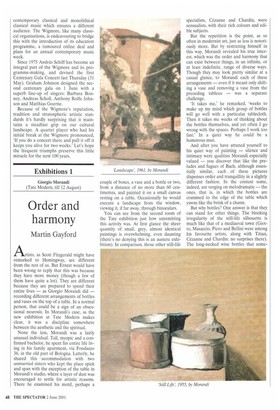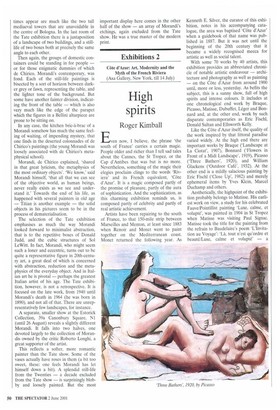Exhibitions 1
Giorgio Morandi (Tate Modern, till 12 August)
Order and harmony
Martin Gaylord
Artists, as Scott Fitzgerald might have remarked to Hemingway, are different from the rest of us. But Ernest would have been wrong to reply that this was because they have more money (though a few of them have quite a lot). They are different because they are prepared to spend their entire lives — as Giorgio Morandi did — recording different arrangements of bottles and vases on the top of a table. In a normal person, that could be a sign of an obsessional neurosis. In Morandi's case, as the new exhibition at Tate Modern makes clear, it was a discipline somewhere between the aesthetic and the spiritual.
None the less, Morandi was a fairly unusual individual. Tall, myopic and a confirmed bachelor, he spent his entire life living in his family apartment, via Fondazzo 36, in the old part of Bologna. Latterly, he shared this . accommodation with two unmarried sisters who kept the place spick and span with the exception of the table in Morandi's studio, where a layer of dust was encouraged to settle for artistic reasons. There he examined his motif, perhaps a couple of boxes, a vase and a bottle or two, from a distance of no more than 60 centimetres, and painted it on a small canvas resting on a table. Occasionally he would execute a landscape from the window, viewing it, if far away, through binoculars.
You can see from the second room of the Tate exhibition just how unremitting this activity was. At first glance the sheer quantity of small, grey, almost identical paintings is overwhelming, even daunting (there's no denying this is an austere exhibition). In comparison, those other still-life specialists, Cezanne and Chardin, were sensualists, with their rich colours and edible subjects.
But the repetition is the point, as so often in modernist art, just as less is notoriously more. But by restricting himself in this way, Morandi revealed his true interest, which was the order and harmony that can exist between things, in an infinite, or at least indefinite, range of diverse ways. Though they may look pretty similar at a casual glance, to Morandi each of these arrangements — even if it meant only shifting a vase and removing a vase from the preceding tableau — was a separate challenge.
'It takes me,' he remarked, 'weeks to make up my mind which group of bottles will go well with a particular tablecloth. Then it takes me weeks of thinking about the bottles themselves, and yet often I go wrong with the spaces. Perhaps I work too fast.' In a quiet way he could be a humorous man.
And after you have attuned yourself to his quiet way of painting — silence and intimacy were qualities Morandi especially valued — you discover that like the preludes and fugues of Bach, although essentially similar, each . of these pictures dispenses order and tranquillity in a slightly different fashion. In the context some, indeed, are verging on melodramatic — the ones, that is, in which the bottles are crammed to the edge of the table which yawns like the brink of a chasm.
But why bottles? One answer is that they can stand for other things. The blocking irregularity of the still-life silhouette is much like that of a mediaeval town (Giotto, Masaccio, Piero and Bellini were among his favourite artists, along with Titian, Cezanne and Chardin: no surprises there). The long-necked wine bottles that some
times appear are much like the two tall mediaeval towers that are unavoidable in the centre of Bologna. In the last room of the Tate exhibition there is a juxtaposition of a landscape of two buildings, and a stilllife of two boxes both at precisely the same angle to each other.
Then again, the groups of domestic containers could be standing in for people — or for those enigmatic dummies of which de Chirico, Morandi's contemporary, was fond. Each of the still-life paintings is bisected by a sort of horizon between darker grey or fawn, representing the table, and the lighter tone of the background. But some have another fainter division, indicating the front of the table — which is also very much like the edge of the parapet which the figures in a Bellini altarpiece are prone to be sitting on, In any case, the kitchen bric-a-brac of a Morandi somehow has much the same feeling of waiting, of impending mystery, that one finds in the deserted colonnades of de Chirico's paintings (the young Morandi was loosely associated with de Chirico's metaphysical school).
Morandi, de Chirico explained, 'shared in that great lyricism, the metaphysics of the most ordinary objects'. `We know,' said Morandi himself, `that all that we can see of the objective world, as human beings, never really exists as we see and understand it.' Towards the end of his life, as happened with several painters in old age — Titian is another example — the solid objects in his pictures seem to be in the process of dematerialisation.
The selection of the Tate exhibition emphasises as much the way Morandi looked forward to minimalist abstraction, that is to the repetitive boxes of Donald Judd, and the cubic structures of Sol LeWitt. In fact, Morandi, who might seem such a loner and eccentric, turns out to be quite a representative figure in 20th-century art, a great deal of which is concerned with abstraction, reduction and the metaphysics of the everyday object. And in Italian art he is pivotal — perhaps the greatest Italian artist of his age. The Tate exhibition, however, is not a retrospective. It is focused on the late work, from 1940 until Morandi's death in 1964 (he was born in 1890), and not all of that. There are unrepresentatively few landscapes, for instance.
A separate, smaller show at the Estorick Collection, 39a Canonbury Square, Ni (until 26 August) reveals a slightly different Morandi. It falls into two halves, one devoted largely to the collection of Morandis owned by the critic Roberto Longhi, a great supporter of the artist.
This reflects a softer, more romantic painter than the Tate show. Some of the vases actually have roses in them (a bit too sweet, these: one feels Morandi has let himself down a bit). A splendid still-life from the Twenties — a decade excluded from the Tate show — is surprisingly blobby and loosely painted. But the most important display here comes in the other half of the show — an array of Morandi's etchings, again excluded from the Tate show. He was a true master of the modern print.











































































 Previous page
Previous page